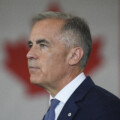This piece originally appeared as part of a Canada Day symposium at Law & Liberty.
The New Republic once ran a contest to see if its readers could come up with a headline more boring than “Worthwhile Canadian Initiative.” The satirical challenge played up a perception of Canada’s political culture as staid, boring, and predictable.
It worked precisely because notwithstanding a hint of hyperbole, the basic premise that modern Canadian life is less assiduous (and less chaotic) than in the United States is mostly accurate. American culture is personified by the frenetic dynamism of Silicon Valley entrepreneurs and Canada has become marked by the technocratic tedium of what historian Jack Granatstein once referred to as the “Ottawa men.”
It wasn’t always this way though. Canada may not have been born out of revolution, but the Confederation project was indeed an act of audaciousness. The piecing together of the separate provinces and different cultures, languages, and religions across the North America continent didn’t just require shrewd judgement and careful negotiation. It also took a spirit of ambition and a vision of greatness to ultimately bring Canada into existence in 1867.
For all of the discussion of Canada’s founders as highly pragmatic, we underestimate their collective boldness as the crucial ingredient in such an exercise of nation-building. Thomas D’arcy McGee, one of the country’s founding fathers (who was subsequently assassinated by a Fenian Brotherhood sympathizer steps from Parliament Hill), reflected such boldness when he famously spoke of Canada’s destiny to be a “great new northern nation.”
This aspiration to greatness long remained core to the Canadian identity. Prime Minister Wilfrid Laurier’s bold admonition that the 20th century would belong to Canada might now sound to modern ears like a kind of jingoism but it reflected a common view at the time that Canada’s potential was unlimited and that greatness for the young country was a fitting aspiration.
Similar levels of grandeur were displayed in the railway projects that connected the country through its highly-challenging terrain, the unprecedented waves of immigrants early in the twentieth century, the breakneck pace of urbanization and industrialization that followed, the Canadian capture of Vimy Ridge in WWI and their heroic contribution to the D-Day invasion in WWII.
Canada was a country on the move. Though smaller in size and stature than the United States, it matched its sense of optimism and confidence in the future. That the country’s post-war baby boom was among the biggest in the world — indeed, the largest in the contemporary G-7 — was itself an expression of national buoyancy.
It’s important to recognize that not every Canadian shared in this sense of opportunity and destiny. The country’s treatment of its Indigenous peoples (including the illiberal and tragic experience of Indian residential schools) was often discriminatory and wrong. The economy and society were patriarchal and conformist. Racism and anti-Semitism were far too prevalent. No one should want to go back to an era that in hindsight was too insular and non-inclusive.
But in today’s “decadent” age of identity politics and technocratic public administration, it can feel like something has been lost. We’ve given up a common sense of national purpose and chosen instead to focus our collective attention on narrow distributional questions. Politics and governance are now dedicated to reconciling competing claims from so-called “equity-seeking groups” for scarce public resources. Greatness is off the agenda.
The question, of course, is: when did this happen? There’s a good case that it occurred in fall 1972.
It may strike some readers as an odd choice to mark the beginning of Canadian decadence because it started in a moment of national triumph. In late September 1972, Canada defeated the Soviet Union in the historic Summit Series hockey games that fully captured the country’s collective attention. Defeating the global superpower in the hard-fought, eight-game series put Canada at the center of the Cold War contest and demonstrated our capacity to compete among leading nations. Paul Henderson’s famous goal with 34 seconds remaining in the final game produced a genuine expression of national fervour.
But it’s what followed barely a month later that matters for understanding modern Canada: voters elected the country’s most socialist government in its history.
There was a high degree of provincialism and protectionism in this unprecedented Liberal-NDP agenda.
The Liberal Party, led by then-Prime Minister Pierre Trudeau, was re-elected in late October 1972 with a plurality of seats in the federal House of Commons but not enough to govern on its own. It needed to rely on the parliamentary support of the even more left-wing New Democratic Party to pass legislation. The two parties worked together in an informal coalition for the next two years to enact a series of inward-looking, highly activist policies including foreign investment restrictions, the establishment of new state-run enterprises, and a general expansion of the size and scope of government.
There was a high degree of provincialism and protectionism in this unprecedented agenda. The implicit message was that Canada would now orient itself to protecting its culture and economy from foreign influences and advancing equity goals through higher levels of government spending. It seems clear in hindsight that this brief, yet formative burst of hyper-progressive policymaking marked a lasting retreat from greatness. Growth and dynamism were replaced by fairness and redistribution. Canadian politics in turn became transactional rather than aspirational.
It’s also a notable year because it represented the growing maturation of baby boomers into voting age. Although Canada’s fertility rate averaged 3.6 children per women between 1946 and 1965 (compared to just 1.47 in 2019), it specifically peaked during the 8-year period between 1954 and 1961 when it consistently reached nearly 4 children per women. Those born at the beginning of this “boom within the boom” were able to vote for the first time in 1972. In hindsight, that election marked the start of the sustained political dominance of the baby boomers which, of course, persists to the present day.
One cannot help but think that these two developments are linked: that the end of greatness and the rise of decadence are manifestations of the culture, economic, and political influence of the baby boom generation.
They came of age animated by progressive ideals about equity, fairness, and rights-based issues and, as such, tilted public and private priorities away from growth, dynamism, and progress. Now, as they reach retirement age, they’ve once again shifted their political attention to financial security, old-age benefits, and health care. The set of issues may be different, but the effect is the same: Canada seems stuck in a 50-year cycle of decadence driven by baby boomers’ demands, interests, and needs.
This has contributed to a mainstream political discourse that’s primarily focused these days on carving up the economic pie as opposed to imagining a different and better future. In such a political milieu, the “Ottawa men” (and increasingly women), who are directly responsible for allocating public dollars to regions, businesses, and individuals, necessarily loom large. The mythology of the determined doer has been supplanted by the rise of the transactional technocrat.
There’s reason, however, to think that this may be starting to shift due in large part to the sweeping effects of the COVID-19 pandemic. Younger Canadians are beginning to express generational identities with their own unique interests and concerns (including house affordability and delayed family formation).
Canadian governments’ poor pandemic performance marked by lengthy and stringent lockdowns may cause citizens to question their “social contract” with a sclerotic state apparatus. The scientific breakthrough of the mRNA vaccines may contribute to greater interest in technology and progress. And the pandemic-induced recession may ultimately lead to renewed commitment to getting out of the “two-percent trap” that has bedeviled Canada’s economy in the twenty-first century.
As we celebrate the 154th anniversary of Canadian Confederation, therefore, we may be on the cusp of reversing the baby-boom induced changes to Canadian political culture that took shape in a short, one-month period in fall 1972. That would indeed be a worthwhile Canadian initiative.
Recommended for You

‘The majority of people still want to get married’: Will Taylor Swift and Travis Kelce’s engagement trigger a marriage renaissance?

Howard Anglin: Just how principled is Mark Carney?

Need to Know: Adulthood is increasingly on hold for young Canadians—and it’s not their fault

‘The Conservatives are holding support much better than Carney is’: Polling shows the Tories overtaking the Liberals on the issues facing Canadians




